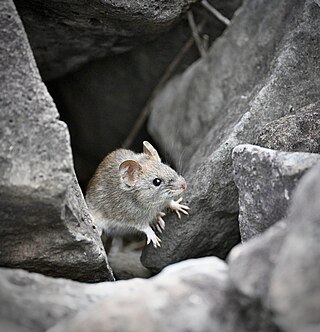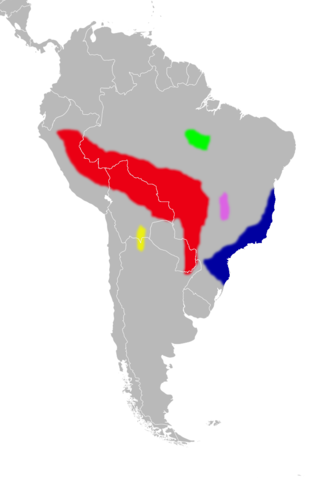Hylaeamys laticeps, also known as the Atlantic Forest oryzomys or the large-headed rice rat, is a species of rodent in the family Cricetidae.
Cerradomys marinhus, also known as Marinho's rice rat, is a rodent species from South America. It is found in Minas Gerais, Brazil. It was formerly known as Oryzomys marinhus, but was transferred to the new genus Cerradomys in 2006.

Euryoryzomys nitidus, also known as the elegant oryzomys or elegant rice rat, is a rodent species in the family Cricetidae. Previously it was known as Oryzomys nitidus, but it is not closely related to Oryzomys as that genus is now constructed. Its range includes Bolivia, Brazil and Peru to the east of the Andes, in lowland tropical rainforest as well as forest in the eastern foothills of the mountains, at elevations from 50 to 2,000 m.
Cerradomys subflavus, also known as the terraced rice rat or flavescent oryzomys, is a rodent species from South America in the genus Cerradomys. It is found in the states of Goiás, São Paulo, and Minas Gerais, Brazil. Populations in Bolivia, Paraguay, and elsewhere in Brazil that were previously placed in this species are now classified as various other species of Cerradomys.
Hylaeamys yunganus, also known as the Amazonian oryzomys or Yungas rice rat, is a species of rodent in the genus Hylaeamys of family Cricetidae. It is found in lowland tropical rainforest throughout Amazonia, in northeastern Bolivia, eastern Peru, eastern Ecuador, southeastern Colombia, southern Venezuela, Guyana, Suriname, French Guiana, and northern Brazil. A closely related species, Hylaeamys tatei, occurs only in a small area in eastern Ecuador. Both were previously placed in Oryzomys.

Pseudoryzomys simplex, also known as the Brazilian false rice rat or false oryzomys, is a species of rodent in the family Cricetidae from south-central South America. It is found in lowland palm savanna and thorn scrub habitats. It is a medium-sized species, weighing about 50 grams (1.8 oz), with gray–brown fur, long and narrow hindfeet, and a tail that is about as long as the head and body. The IUCN has assessed its conservation status as being of least concern, although almost nothing is known about its diet or reproduction.

The Galápagos rice rat, also known as the Galápagos oryzomys, is a species of rodent that is endemic to the Galápagos Islands.

Euryoryzomys lamia, also known as the buffy-sided oryzomys or monster rice rat, is a species of rodent in the family Cricetidae. It is found only in central Brazil, where it lives in forest enclaves within the cerrado. The species' known altitudinal range is from 700 to 900 m. The main threats to its survival are the destruction and fragmentation of its forest habitat.
Euryoryzomys legatus, also known as the Tarija oryzomys or big-headed rice rat, is a species of rodent in the family Cricetidae. It now belongs to the genus Euryoryzomys, having previously been placed in Oryzomys. It is found in the eastern Andes of northwestern Argentina and southern Bolivia.
Nephelomys levipes, also known as the nimble-footed oryzomys or light-footed rice rat, is a species of rodent in the genus Nephelomys of family Cricetidae. It is found on the eastern slope of the Andes from southeastern Peru into west-central Bolivia in cloud forest at elevations from 1,800 to 3,200 metres. It occurs in the same general area as its congener N. keaysi, but at higher altitudes.

Eremoryzomys polius, also known as the gray rice rat or the Marañon oryzomys, is a rodent species in the tribe Oryzomyini of the family Cricetidae. Discovered in 1912 and first described in 1913 by Wilfred Osgood, it was originally placed in Oryzomys and named Oryzomys polius. In 2006, a cladistic analysis found that it was not closely related to Oryzomys in the strict sense or to any other oryzomyine then known, so that it is now placed in its own genus, Eremoryzomys. The Brazilian genus Drymoreomys, named in 2011, is probably the closest relative of Eremoryzomys. Eremoryzomys has a limited distribution in the dry upper valley of the Marañón River in central Peru, but may yet contain more than one species.
Aegialomys xanthaeolus, also known as the yellowish oryzomys or yellowish rice rat, is a species of rodent in the family Cricetidae. It belongs to the genus Aegialomys in tribe Oryzomyini, which was not recognized as distinct from Oryzomys until 2006. It is found in coastal Ecuador and Peru. Though it is currently the only formally recognized mainland species of Aegialomys, at least one other exists. The specific name is sometimes incorrectly spelled "xantheolus", without the second "a".

Oryzomyini is a tribe of rodents in the subfamily Sigmodontinae of the family Cricetidae. It includes about 120 species in about thirty genera, distributed from the eastern United States to the southernmost parts of South America, including many offshore islands. It is part of the clade Oryzomyalia, which includes most of the South American Sigmodontinae.

Cerradomys is a genus of oryzomyine rodents from eastern Bolivia, Paraguay, and central Brazil found in cerrado, Caatinga and Gran Chaco habitats.
Cerradomys maracajuensis, also known as the Maracaju oryzomys, is a rodent species from South America. It is terrestrial and is found in gallery forests in Bolivia, Paraguay and nearby Brazil and Peru. It was first discovered near the Brazilian city of Maracaju.
Hylaeamys acritus, formerly Oryzomys acritus, is an oryzomyine rodent of the family Cricetidae. The name is derived from the Greek word ακριτος 'confused, doubtful', because it could easily be confused with species such as H. megacephalus and Euryoryzomys nitidus. It is known only from northeastern Bolivia; its type locality is within Noel Kempff Mercado National Park. The rodent is terrestrial and is found in moist lowland semideciduous forest and savanna. It has olive brown coloration on its back; the cheeks and flanks are amber, and the top of the head is dark. The coat is 9 mm long at the center of the torso. Chest fur between the front legs is thick and 3 to 4 mm long. Abdominal hairs are gray at the base and white at the top.

Euryoryzomys is a genus of rodents in the tribe Oryzomyini of family Cricetidae. It includes seven species, which are distributed in South America. Until 2006, its members were included in the genus Oryzomys, but they are not closely related to the type species of that genus, and therefore they were placed in a new genus. They are most closely related to genera like Hylaeamys and Transandinomys; many members of these genera were previously placed in a single species, known as Oryzomys capito. The genus name, Euryoryzomys, combines the name "Oryzomys" with the Ancient Greek word eurus "broad", referring to the broad range in distribution of the genus.
Cerradomys langguthi is a species of rodent from South America in the genus Cerradomys. It occurs only in northeastern Brazil and was formerly included in C. subflavus.
Cerradomys vivoi is a species of rodent from South America in the genus Cerradomys. It occurs only in eastern Brazil, in the states of Bahia, Goiás, and Sergipe, and was formerly included in C. subflavus.
In anatomy, posterolateral palatal pits are gaps at the sides of the back of the bony palate, near the last molars. Posterolateral palatal pits are present, in various degrees of development, in several members of the rodent family Cricetidae. Many members of the family lack them or have only simple pits, but Arvicolinae and Oryzomyini have more highly developed posterolateral palatal pits. Posterolateral palatal pits are also present in some other rodents, including Glis, Jaculus, Hystrix, Abrocoma, Ctenomys, Chinchilla, and Lagidium.







